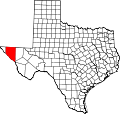Etholen, Texas | |
|---|---|
| Coordinates: 31°13′32″N105°25′28″W / 31.22556°N 105.42444°W | |
| Country | United States |
| State | Texas |
| County | Hudspeth |
| Elevation | 4,646 ft (1,416 m) |
| Time zone | UTC-6 (Central (CST)) |
| • Summer (DST) | UTC-5 (CDT) |
| ZIP codes | 79839 |
| Area code | 915 |
| GNIS feature ID | 1379738 |
Etholen is a ghost town in Hudspeth County, Texas, United States, allegedly located four miles west of Sierra Blanca. [1] Different sources claim different things about when the town was founded, but particularly it was during the 1880s. [2] Etholen never grew to more than a small railroad station on the Southern Pacific Railroad, as the population was fewer than 25 by the mid-20th century. Etholen was removed from maps in the 1960s.

